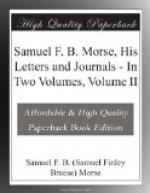With sincere respect and Christian regard I remain, my dear madam
Your most obedient servant
S.F.B. MORSE.
Before closing the record of this European trip, so disappointing in many ways and yet so encouraging in others, it may be well to note that, while he was in Paris, Morse in 1838 not only took out a patent on his recording telegraph, but also on a system to be used on railways to report automatically the presence of a train at any point on the line. A reproduction of his own drawing of the apparatus to be used is here given, and the mechanism is so simple that an explanation is hardly necessary. From it can be seen not only that he did, at this early date, realize the possibilities of his invention along various lines, but that it embodies the principle of the police and fire-alarm systems now in general use.
It is not recorded that he ever realized anything financially from this ingenious modification of his main invention. Commenting on it, and on his plans for a military telegraph, he gives this amusing sketch:—
“On September 10, 1838, a telegraph instrument constructed in the United States on the same principles, but slightly modified to make it portable, was exhibited to the Academy of Sciences in Paris, and explained by M. Arago at the session of that date. An account of this exhibition is recorded in the Comptes Rendus.
“A week or two after I exhibited at my lodgings, in connection with this instrument, my railroad telegraph, an application of signals by sound, for which I took out letters patent in Paris, and at the same time I communicated to the Minister of War, General Bernard, my plans for a military telegraph with which he was much pleased.
[Illustration: RAILWAY TELEGRAPH DRAWING BY MORSE Patented by him in France in 1838, and embodying principles of Police and Fire Alarm Telegraph]
“I dined with him by invitation, and in the evening, repairing with him to his billiard-room, while the rest of the guests were amusing themselves with the game, I gave him a general description of my plan. He listened with deep attention while I advocated its use on the battle-field, and gave him my reasons for believing that the army first using the facilities of the electric telegraph for military purposes would be sure of victory. He replied to me, after my answering many of his questions:—
“‘Be reticent,’ said he, ’on this subject for the present. I will send an officer of high rank to see and converse with you on the matter to-morrow.’
“The next day I was visited by an old Marshal of France, whose name has escaped my memory. Conversing by an interpreter, the Reverend E.N. Kirk, of Boston, I found it difficult to make the Marshal understand its practicability or its importance. The dominant idea in the Marshal’s mind, which he opposed to the project, was that it involved an increase of the material of the army, for I proposed




